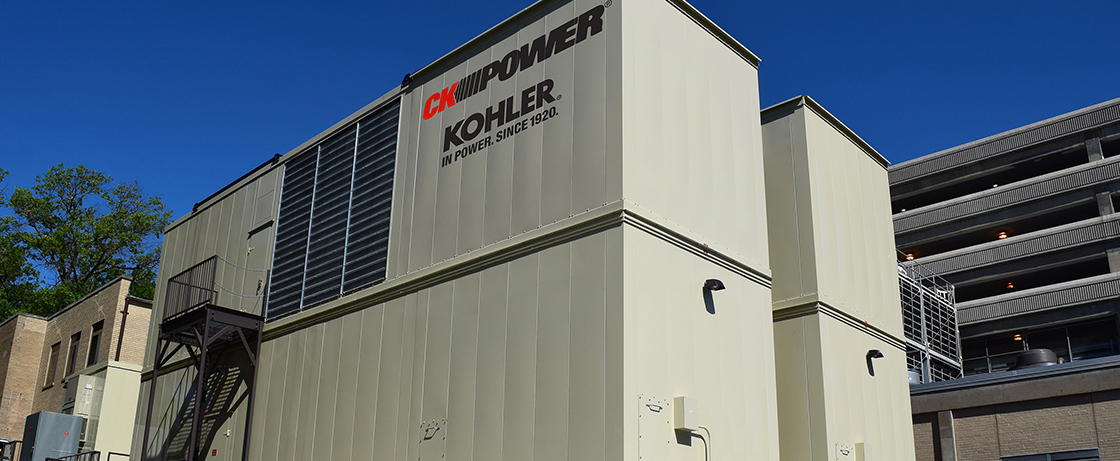
SSM Health St. Mary’s in Richmond Heights is a Level III Neonatal Intensive Care Unit. Within its walls, mothers and their newborns —some born as early as 28 weeks— are fighting for their lives. And in 2016, we were awarded the contract for its standby power system.
This was more important than keeping the lights on — this was about providing dependable, responsive backup power for babies in critical condition. The medical equipment housed there must be powered at all times, especially in an emergency.
We understood this. And our team worked tirelessly to design and deliver a standby system that not only achieved regulatory compliance, but would also reliably serve the occupants of this critical care facility for years to come.
Designing and installing an emergency power system in a fully operational hospital
St. Mary’s required 4000 kW of reliable standby power, which would replace the three generators currently supplying backup power. This project was a retrofit, adding another layer of complexity: We needed to meet the existing space requirements and install our design without disturbing the existing patient population.
Our engineering team worked with Kaiser Electric —the engineer of record on this project— to design, engineer and deliver an emergency power system for St. Mary’s that overcame these challenges, achieved regulatory compliance and minimized disturbance to its patients. The goal was to design a system that empowered the doctors at St. Mary’s to continue serving their patients with the highest level of care, no matter what.
Dependable power requires dependable generators
Standby power systems supporting life-safety equipment and systems must be switched on and carrying loads within 10 seconds of a power outage, according to NFPA 110. We partnered with Kohler Power Systems to supply generators that would meet these requirements when properly equipped and installed: Two 2000 kW Kohler diesel generators which were EPA Tier 2 certified for stationary emergency power.
We equipped each unit with the following features:
- 1988 kW (2500 kVA) Marathon 4-pole, rotation field, pilot-excited, permanent magnet brushless alternator for short-circuit protection and load response.
- 367 L (97 gall) radiator system.
- 2057 mm (81 in.) diameter 81 kWm (109 hp) fan.
- Fire suppression system.
- Paralleling gear.
- Custom-engineered sound enclosure.
- 2180 kW (2923 BHP) Mitsubishi S16R-Y2PAW2-1 Turbocharged 16-cylinder diesel engines.
- Kohler Decision-Maker® 550 controller.
- A 5300 L sub-base diesel fuel tank.
While these units served as the basis of St. Mary’s emergency power system, our team had to engineer smart solutions to achieve low sound levels and meet strict space constraints of a fully functional hospital.
Overcoming strict sound attenuation requirements
The standard for sound attenuation is 75 dB(A) at 23 feet (a measure for how sound is heard by the human ear). For this project, we had to meet a sound level of 57 dB(A) at 23 feet — which required a custom enclosure.
Our engineering team collaborated with Chillicothe Metal Co. to fabricate an enclosure outfitted with a sound silencer, fans, insulation and baffles to achieve the required sound levels. To make sure our units met the required noise levels, we assembled and testing them at Chillicothe’s facility before bringing them on the grounds of St. Mary’s.
These units —with the custom sound enclosure, 5300 L fuel tanks and ancillary equipment— were immense. We separated each generator into three pieces to safely transport the units to the grounds of St. Mary’s.
Meeting strict regulations: A standard part of our process
Regulatory hurdles are high in the healthcare industry, and this project was no exception. NFPA 110, NFPA 99, the Joint Commission, FM Global standards, IBC seismic requirements, the National Electrical Code® and more all had to be followed to the letter. We built compliance into the design of the system, and ensured the installation followed suit.
The NICU absolutely needed to be ready in January 2018. Our team —along with the hard work of Kohler, Kaiser and Chillicothe— was instrumental to making this happen, meeting the August 2017 deadline for installing the new emergency power system.
And even today, we’ve continued to provide all the record keeping and service needed to comply with generator testing and maintenance regulations for healthcare emergency systems as a standard part of our preventative maintenance contract.
Talk to us about your critical backup power needs
Healthcare facilities can’t afford downtime. At CK Power, we know this and take every healthcare emergency power project seriously — providing compliant, quiet, reliable solutions tailored exactly to the facility’s needs.
Whether you need a permanently installed standby power system, or a never-before-seen custom power solution, our team will help. Request a consultation today to begin discussing your facility’s backup power needs. We’ll have our best looking into how we can ensure your patients’ safety, no matter what.